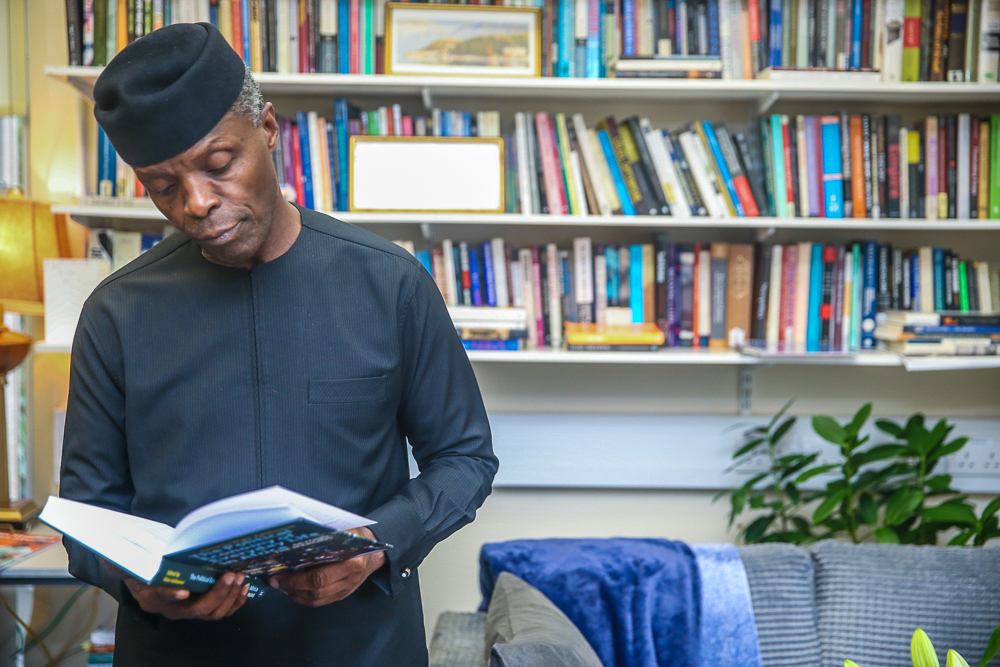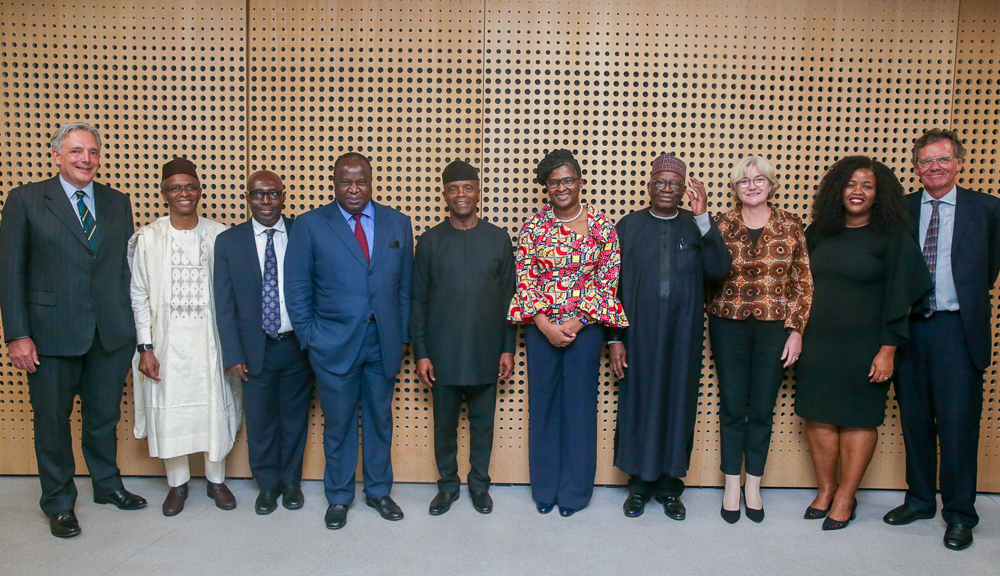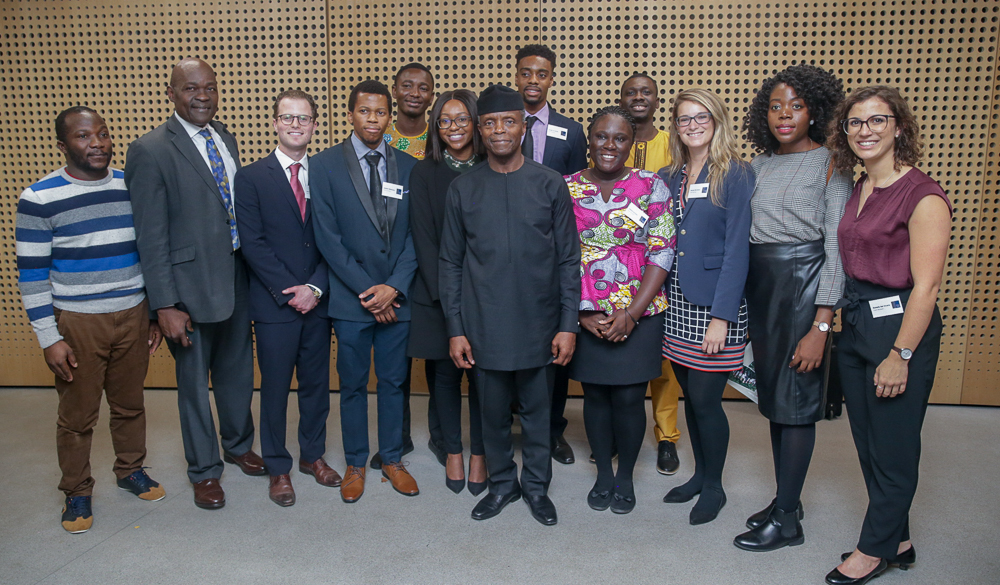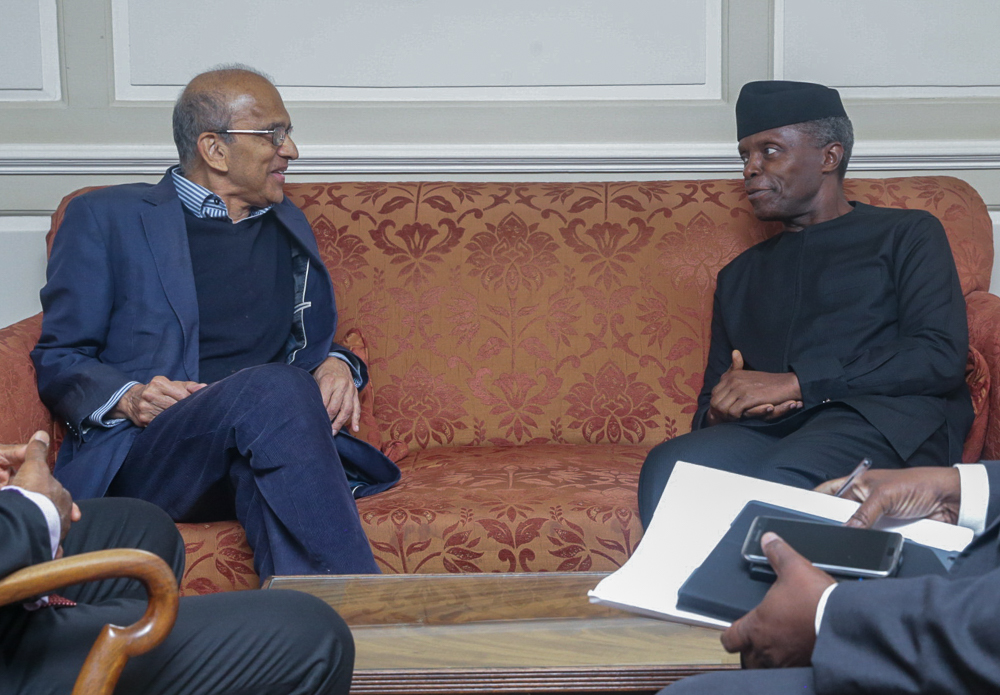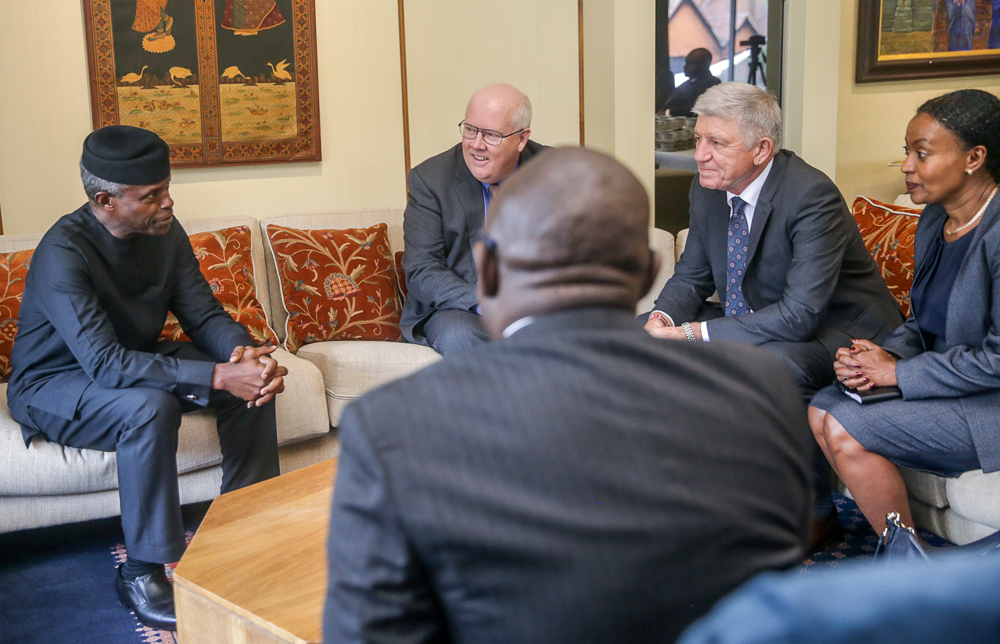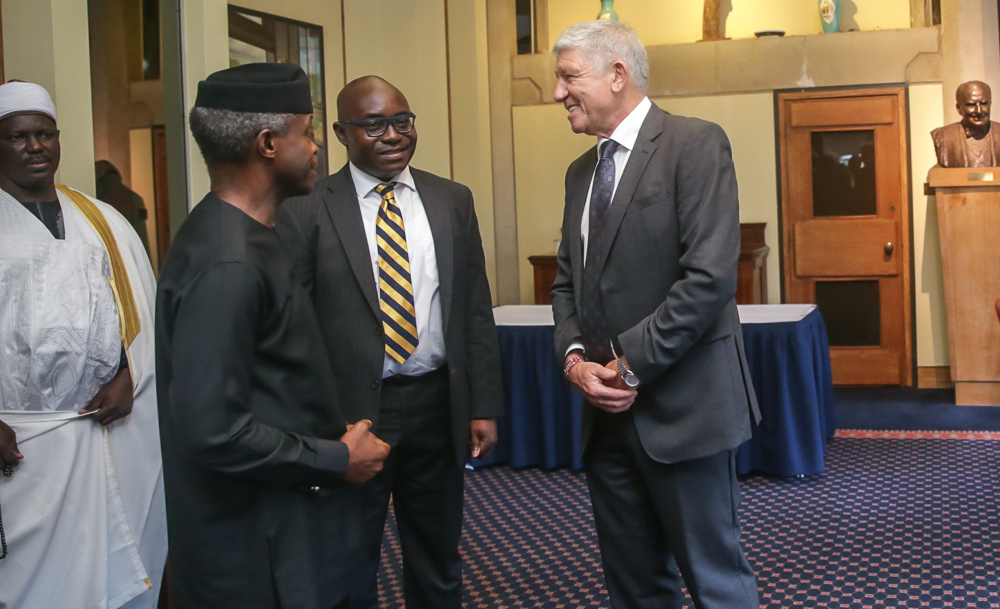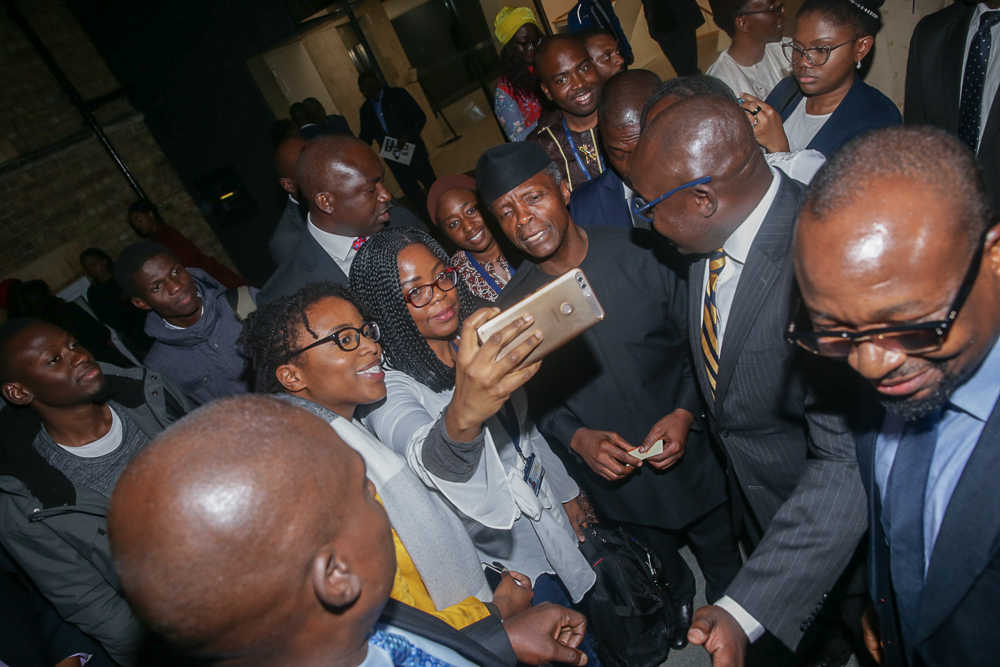Special Lecture On “The Challenges Of Human Development In 21st Century Africa”, African Studies Centre, Oxford University, UK
*Nigerian government investing in its people through several initiatives, including its social Investment programme
*N-Power, largest job programme in Africa, set to train 10m Nigerian graduates by 2023
*Over 9.2 million children in 26 states in the country provided free daily meals
*Nigeria’s Family Homes Fund to provide up to 500,000 housing units by 2023
TRANSCRIPT OF SPEECH DELIVERED BY HIS EXCELLENCY, PROF. YEMI OSINBAJO, SAN, THE VICE PRESIDENT, FEDERAL REPUBLIC OF NIGERIA, AT A SPECIAL LECTURE ON “THE CHALLENGES OF HUMAN DEVELOPMENT IN 21ST CENTURY AFRICA,” HELD AT THE AFRICAN STUDIES CENTRE, OXFORD UNIVERSITY, UNITED KINGDOM, ON FRIDAY, 12TH OCTOBER, 2018.
PROTOCOLS
I really am extremely pleased to be here and very deeply honoured to have been invited to speak here today. Although clearly, Oxford’s study of Africa is decades ahead of the 2004 establishment of the Centre, it is commendable indeed that the Africa Studies Centre has, in a few short years, become one of the world’s leading centres of African Studies. But this Centre’s role in especially the shaping of policy and ideas is bound to become more crucial as Africa enters possibly its most decisive two decades.
This is because it is evident that there are at least four important respects that Africa will hold the balance of world development in the next two decades. The first is in World Population (demography), the second is environment and climate change. The third is in production especially agriculture, manufacturing and technology, and the fourth is in social exclusion, under which rubric comes poverty and human capital development, and its implications for global security. Africa’s failure or success on these issues will profoundly impact the fortunes of mankind. And I don’t think that that overstates the point at all. But as interlocutors in this imminent dispensation, your work is certainly cut out for you.
This afternoon, I will be speaking for a few minutes on a sub-theme on one of those defining issues: ‘The Challenges of Human Capital Development in 21st Century Africa.’
But as you might guess, I will, in the course of the lecture, draw mainly from the Nigerian experience. As a political functionary of one of Africa’s 54 States, I am never quite certain of the diplomatic implications of reeling out bad statistics about other States. For my country, it isn’t such a problem, I know what the opposition will say. They will say, “Nigeria, the Vice President admits that the government is messed up, or “at last the truth is out,” something like that. So, at least we can handle that, we deal with that every day.
But seriously though, Nigeria accounts for 20% of Africa’s population and its performance weighs quite heavily on continental indices. Nigeria is already beginning to show up in global discourse sometimes as having the highest number of people in absolute poverty, although there are disputes here and there about that. Its progress therefore matters because, by current projections, it will be the third most populous country in the world in 2040 with up to 400 million people. This is in just 22 years. Of course, if we get it right, and we must, such a population could herald a demographic dividend. The alternative scenario, of course, is a perfect storm of population pressures on natural resources, the socio-economic consequences of a huge jobless youth population and climate change-induced environmental damage.
To get some clarity about the concept of Human Capital Development, it is perhaps useful to note that it is sometimes described from the prism of absolute values, but I think its more popular iteration today is as a relative measure of achievements in human progress. Considerable effort has gone into developing parameters for its measurement. I’m sure we are very familiar with several of these parameters; the Human Development Index or HDI of the UNDP, which assesses progress in health, knowledge and income per capita. The HDI has, itself, spawned many refinements and derivatives, including the Multidimensional Poverty Index developed here at Oxford by the Oxford Poverty and Human Development Initiative. And, of course, this measures a plethora of indices which relates generally to the impact of individuals and communities at the household level; such as lack of access to toilets, water, electricity, cooking fuels and such like. Then we have the Gender Inequality Index, which evaluates the percentage of potential development that is lost due to gender inequality across various dimensions including reproductive health, economic participation and political leadership. The World Bank Human Capital Index, which will be released sometime today focuses on child survival, education and health.
As you probably know, there is considerable overlap in these indexes which is not surprising given that they share a common provenance with the capabilities approach of Amartya Sen. He’s the one who developed this idea that places emphasis on the capability or freedom of individuals to live the kind of lives they value rather than on the availability of resources to live a good life. In other words, understanding what sorts of deprivation prevent the ability to live a good life is a better metric for human capital development than focusing merely on income per capita.
The various indexes are useful snapshots of the issues that matter in ensuring that human capital contributes to future growth, and they make at least three important points. The first is that human capital development is inextricably linked to multidimensional poverty. Not surprisingly, the countries that perform worst in the measurements of human capital also have to contend with poverty. According to the World Bank, human capital explains up to 30% of the differences in per capita between countries.
Another insight to be gleaned from the various indexes is that Africa, especially sub-Saharan Africa, is lagging behind the rest of world in terms of human capital development. The highest ranked African country in the Human Development Index is number 63 in the world. The scale of poverty in Africa is huge by any of the measures that we use. While the proportion of poor Africans living below the current level of absolute poverty of less than $1.90 has reduced from 56% to 40% more recently, the absolute numbers may actually have increased from about 280 million people to over 400 million people today. Of course, this is on account of the huge population growth rates.
Human capital development in Nigeria, Congo and Ethiopia, three of the larger countries in Africa by population size, is also unsatisfactory. Despite recent improvements, Nigeria is ranked 157 out of 189 countries in the world in the UNDP Human Development Index, while Congo was ranked 176 and Ethiopia 173.
In terms of education, two in five Africans are still illiterate and despite increases in enrolment there are still huge gaps in the quality of education. Nigeria has over 9m out- of- school children of primary school age, which is said to be the highest in the world. Of those in school, only 20% of those who completed public primary education were found to be able to read. And we’re looking at statistics from about five years back.
The picture is not much different for health outcomes, although substantial progress has been made in some areas such as tackling malaria and eradicating polio. Nigeria is one year away from being certified polio-free. However, there is still a lot more to be done. Malaria, diarrhea and pneumonia, which are treatable, account for 74% of under-five mortality in Nigeria, and which, if things do not change, is projected to have the most under-5 deaths in the world by 2021. The picture of under-five malnutrition and stunting is also dire.
A disaggregation of the indexes at regional and national level also reveals huge disparities in regional and sub-national performance. While no African country is in the very high category at global level, five countries are considered to have a high human development index, thirteen of them are in the medium category while 32 of them populate the lower end of the index. These disparities are not much different at the sub-national level in Nigeria. While the proportion of children out of school in the total population of a State, for example, in Lagos, is just 1.83%, Gombe State in the North East of Nigeria has 24.12%. In Anambra State, a state in the South East, the proportion of children of school age out of school is 6.22%, while in Bauchi State in the North, it is 55.59%. These disparities also reflect, to some extent, the attention that the individual states pay to these issues, especially as primary and secondary education are really subnational matters.
Also useful as all these metrics are to show the scale of the challenge, they can neither by themselves convey the reality of the misery of poverty, nor can they reflect the psychological burden of poverty or the reality of poverty as exclusion, which is so poignantly put by Mother Theresa who said, “Being unwanted, unloved, uncared for, forgotten by everybody, I think that is a much greater hunger, a much greater poverty than the person who has nothing to eat”. This loss of dignity and disempowerment is in many ways the face of poverty anywhere in the world and consequently of poor human capital development.
So, what are the key factors responsible for poor human capital development in Africa? I’m sure as I go through them, you would see that some of them sound like consequences, as well as causes. These include poverty, unemployment, conflicts, climate change and environment, poor policy choices, corruption and the phenomenon of illicit financial flows, and under-investment in human capital development. Some of the causes such as poverty, for example, are at once a cause and a consequence of poor human capital development. The poor, are of course, unable to procure their basic needs in education, in healthcare and living standards. Destitute families do not have the wherewithal or savings to invest in their children’s education, and healthcare is either not available or prohibitively expensive. In Nigeria for instance, 72% of health care is paid out of individual pockets, which means that the poor and destitute will find it difficult to access even basic health services. Unemployment rates are high on the continent, simply because of the number of new entrants to the job market far outstrips the pace of job creation. Even for the employed, decent incomes are required if we are to make any sort of dent on poverty, on human capital development.
Conflict is also, of course, a source of poor human capital formation. Paul Collier has estimated for instance that typically, a seven-year civil war will reduce GDP by 15% over that period, roughly about 2% every year. Certainly, there is some merit in these arguments. The North-East of Nigeria, which has been an arena for a brutal terrorist campaign by Boko Haram, and lately ISIS West Africa, has seen an attendant decline in farming and other commercial activity; the rise in malnutrition, disruption of education, and of course, the consequence is low level of human capital development. Although, as I will point out later, Borno State really offers some interesting dimensions, especially in more recent times. We will come to that in a moment.
The environment and climate change are increasingly becoming also one of the most prominent inhibitors of human capital development in Africa, especially with the rise in extreme weather events such as flash floods, desertification, drought, and unseasonal occurrences, and several other events that have created problems for those who farm and for different forms of livelihood. Recently, we had in Nigeria terrible flooding in nine states, several farmlands have been destroyed on account of this, and several homes have been under water. This is likely on account of climate change.
Lake Chad, Africa’s fourth largest lake, surrounded by Nigeria, Niger, Chad and Cameroon, in 1960 covered over 25,000 square kilometres. Today, it has shrunk to less than 1,350 square kilometers. So, the water it provided for irrigation, fishing, and livestock for millions who live in that neighbourhood is now practically non-existent.
Poor policy choices, including structural adjustment programmes must also take some of the responsibility for poor human capital development outcomes in Africa. At the height of the structural adjustment programmes in Africa, UNICEF commissioned a path-breaking study called ‘Adjustment with a Human Face’. Essentially, that study highlighted the negative impact that structural adjustment policies were having on education, health and child welfare and they called for more attention to be paid to human development and poverty in the design of adjustment programmes. Economic policies in nations with large numbers of the poor must prioritize that sort of reality.
But closely linked to the issue of poor policy choices is the problem of illicit financial flows from Africa, and, of course, it is all related to the general question of corruption. According to the Mbeki High Level Panel on Illicit financial flows comprising tax evasion, money laundering and abuse of public trust, that report says that these various problems are responsible for a minimum outflow of $80 billion from Africa. The Panel found that illicit financial flows had a direct effect on the provision of school clinics, sanitation, security, water and social protection. It cited a study showing that illicit financial flows impacted negatively on achieving the infant mortality targets of the Millennium Development Goals. It found that without illicit financial flows, the Central African Republic, for example, would achieve its MDG targets in 4 categories in 45 years instead of 218 years at the current rate of progress. Equally striking was Mauritania, where the same target would be achieved in 19 years instead of 198 years, and the Republic of Congo in 10 years rather than 120 years. More interesting was the finding that if illicit financial flows had been arrested by the turn of the century, Africa would have met its MDGs 4 targets by 2016.
Now, the question, of course, is that very frequently, we are unable to understand, or our publics are unable to understand the impact of corruption on living standards, the impact of corruption on human capital development, because we don’t make these sorts of connections. People don’t understand those connections. For example, I was saying that there was a fraudulent oil contract in Nigeria that cost us Three Billion dollars ($3B); three billion dollars was stolen on account of this fraudulent contract about five years ago. Now, just $1 Billion of that amount of money would have accounted for our education and health budget. You can imagine what $3B would have done. Now, those connections are sometimes difficult for people to understand, unless they are made repeatedly, because people even sometimes say to you that. Many, especially in Africa, very few actually people pay taxes. Now, when people don’t pay taxes, it is very difficult to understand when you say some people have stolen large sums of money. So, if you don’t pay taxes, it is very difficult for you to quickly see the link between how this affects you. But in places where taxes are paid and those who pay taxes, it is easy to say that a fellow has stolen taxpayers’ money. And I think that it is important to explain sometimes why people sometimes get away with any kind of explanation for stealing public resources and the way that accountability sometimes is slow, the way that the law is sometimes slow in catching up with these individuals.
Under-investment is, without a doubt, is a contributory factor to low human capital development in Africa. In circumstances in which the poor are unable to invest in their human capital needs, the onus may fall on governments to do so. However, this has historically been difficult because of resource constraints. Apart from losses due to leakages, government revenue may be constrained by a low economic base, poor tax administration and existing indebtedness. In the case of Nigeria, under-investment reflects a historical failure to give required priority to spending on human capital requirements. Until recently, Nigeria did not have a programme dedicated to social protection on a large scale such that despite having the highest poverty rates amongst lower, middle and income countries, it spent only 0.3% of GDP on social protection, as of 2014 and prior to 2015. Prior to recent interventions, our public health spending as a proportion of GDP was also said to be one of the lowest. The Federal Government’s capital allocation to the health sector was increased from N22.7bn in 2015, to N86.5bn this year, while the allocation to education increased four-fold from N23.5bn in 2015 to N102bn in 2018.
Interesting fact that a lot of our political opponents don’t want to hear, is the fact that despite earning 60% less, we are doing four or five times more in terms of investment in human capital development.
Let me look quickly at government’s role in providing Human Capital. Clearly, improving human capital development must be a priority of public policy. Indeed, given the scale and extent of multidimensional poverty in Africa, governments have a moral obligation, nay, a duty to put human capital development at the very top of their concerns. The moral case is clear and it is also in our collective interests to do so. Poverty, illiteracy, destitution, and a lack of jobs and economic opportunity often feed into feelings of marginalization and dislocation. These, in turn, manifest in social tensions and communal conflict, and sometimes over scarce resources as a result of population pressures and environmental degradation. In its multidimensional form poverty also implies a deficit in the human capital that underpins long-term development.
As policymakers, our very first instinct in tackling poverty is to bake a larger pie by boosting growth so that there is more to go round. However, in the face of high inequality, rapid growth by itself cannot translate to reduced poverty. Indeed we have seen in Nigeria that at a time of growth in the order of 6 – 7%. unemployment increased, the phenomenon, we are told, of jobless growth.
Botswana is consistently cited as a country with appreciable growth over the long term, but the inequality also is significant. Perhaps, the best we can say in the circumstances is that there is some nexus between growth and human capital development that leads to desired reductions in poverty, perhaps through expanded opportunities and the skills and health to hold down jobs. But clearly, this simply cannot match the scale and speed of interventions that are required to improve health and educational outcomes in Africa.
Now, this is the rationale for the provision in Nigeria’s Economic Recovery and Growth Plan for a pillar which we describe as ‘Investing in our People’. Again,
this pillar is particularly important. I’ll talk just a little bit about how we have taken this into actual policy and how we’ve implemented it. We will come to that in a moment.
But it is government that has the powers of taxation needed raise the resources for wide-spread provision of basic social needs. Government also is best placed to deploy the public policy tools required to bring about synergy between growth objectives and social needs. Most notable in this regard would be striking a balance between expenditure items in the public budget, especially capital expenditure that will boost growth in the long-run and direct provision of resources to tackle poverty. This trade-off is not always an easy one to make, especially when resources are scarce.
One of the very frequent arguments that we have at Budget meetings and Economic Management meetings is really the whole question of how much should you put into social protection; how much should you put into social investments? In almost a sense, social investment is a sort of thing that you make, it is almost like almsgiving; so you really need to be convinced about it almost to a spiritual level to get people to understand how important this is in terms of economic policy. And these arguments continue. But I think that people are beginning to accept more that this, especially for poor countries, for countries with large numbers of poor people, that this should be the beginning of economic plan, it should be the priority of economic plan.
When times are hard, some people see interventions to mitigate the effects of poverty as pandering to people who are not working while others are struggling to make ends meet.
For instance, we’ve had some arguments recently; we got funds which were returned what is described as the Abacha loot of $320 million; it was returned to Nigeria from where it was stuck after the attempt to steal it, in Switzerland. Now, the Swiss court actually said that it was only going to be released on the condition that it was applied to some social cause, with the supervision of the World Bank. Of course, we argued back and forth about that, but eventually we agreed. But when we now decided to apply it to our Conditional Cash Transfer scheme, there were several people who argued, “why are you giving all this money away, and why didn’t you go and build infrastructure or do something with it?” So, we are always going to have those tensions whenever you are putting money aside for social development or social investments; there will always be those arguments about whether or not this isn’t just a waste of money.
We’ve seen that non-governmental organisations and philanthropic organisations, also help to bridge funding gaps. In Nigeria, for example, significantly, the Dangote Foundation, with its partner, the Bill and Melinda Gates Foundation, work closely with the government and international partners to scale up interventions, in healthcare. Similarly, the Tony Elumelu Foundation has become well known for its interventions in providing entrepreneurship training, not just in Nigeria, but across Africa. We found in Nigeria that with a strong will on the part of government; I take, again, the example of Borno State Government, in North East of Nigeria, and its willingness to partner non-governmental organisations, they were able to contribute to noteworthy educational outcomes. So, despite a brutal insurgency and terrorism of Boko Haram, Borno was able to maintain relatively low levels of out-of-school children as a share of local population. The percentage was 16.3%, which was not much higher than the levels in the South and one-quarter of the level in the neighbouring Gombe State, for example.
So, it is possible where there is very active participation of the state government, working with development agencies, and where there is political will. I must also say that Kaduna State has also shown great political will and work with many development agencies. In fact, some people ask why it is that all the development agencies spend all their time in Kaduna State. I suspect that it has to do with some of the kilishi, which is a local delicacy.
Let me talk very quickly about some of the Human Capital Development initiatives that we’ve tried to introduce in Nigeria. To promote growth, we have accorded priority to macroeconomic stability and continued diversification of our economy from direct and indirect dependence on crude oil exports.
Now, this is quite an important point, because generally speaking, of course, we know that when oil prices rise, there is growth. Now, I don’t want to go into too much of the details of that. But the truth of the matter is that rising oil prices or increased oil production, does not, of itself, create jobs, because the oil industry by itself has very few companies. So, there is a need to use the oil resources to diversify the economy. So, those who say that we should no longer depend on oil are always faced with the argument that we need this oil so that we can diversify; we need oil so we can get away from oil. So, we see that there is always this tension.
We have also prioritized spending on infrastructure; rail, roads, and power in particular. Despite earning 60% less, as I said, than previous administration, we have spent N2.7 trillion in two budget cycles on capital, the highest in the nation’s history. We’ve also executed a comprehensive phased plan for ease of doing business which earned us 24 places higher in the World bank ease of doing business index and commendation as one of the top ten reforming economies in the world.
We are also were particular about reducing inflation, which eats into limited purchasing power, especially of the poor who do not have much of a choice in changing the basket of goods they consume. However, a major premise of our economic model was the focus on empowering the jobless youth and millions in extreme poverty by a mix of micro-credit schemes, welfare for the most vulnerable and direct creation of jobs.
So, we adopted a policy of support for rural farmers by the provision of direct credit to farmers at below market rates in what we describe as the Anchor Borrowers Programme. Now, that programme is planned to create a linkage between large anchor companies and small holder farmers of specified commodities. The idea is to provide subsidized credit to small-holder farmers so that they can boost production with guaranteed uptake by the anchor companies. So far, we’ve spent a total of about N55 Billion and we’ve disbursed it to close to 300,000 farmers, and another 250,000 farmers are waiting for their own disbursements.
So, this direct credit to farmers is one that we found to work very well indeed, especially with rice production. We were importing $5 million of rice every day in Nigeria, up until the end of 2016. We are no longer importing that, we are down to two per cent of imports (of rice), and we are now producing about 17 million metric tonnes of paddy rice. We are thinking of milling that rice; we think that we will be completely self-sufficient in rice production, in tomato production, and several others. Of course, there is arable land, the resources are there, and there is absolutely no reason why we should be importing food in the way that we have been importing food. But it always takes a downturn in oil prices, it always takes some action for us to realize that we can do all of these things ourselves.
We also launched our energizing economies project, which is basically providing renewable energy, solar power in particular, to markets and economic clusters for small businesses and traders. So, the whole idea of this is that we are providing power directly in markets, and we are using solar power in particular in several markets across the country. For those who know the country well, Ariaria market in Aba is one of the largest markets that we have in the country, and we have put solar in Ariaria market. We have done about 31,000 shops in all; Sabongari market in Kano, we’ve done over 13,000 shops; Sura market in Lagos, for those who know the place, 1,047. In general, we’ve done over 81,000 shops servicing about 320,000 MSMEs.
Now, the idea, of course, is that, for those who are familiar with the power problems that we have in Nigeria; we decided that we needed to power economic clusters, especially where you have small businesses, because small businesses really are the life and soul of the economy. So, we decided that it would make more sense to actually take the power to those economic clusters where people were doing their business – different businesses and economic activities. And we have really seen tremendous improvements in the output of those individuals. So, one thing, they are able to stay longer, for those who want to work later into the evening; they are able to. They are able to refrigerate their products; including those who sell livestock, and various things.
But, perhaps the most far reaching policy that we have implemented is the Social Investment Programme. In 2016, we budgeted a sum of about N500 billion, it’s close to $1.5 billion, for a multidimensional Social Investment Scheme. This is the largest provision for Social Investment in our Nation’s history. We made the same provision in 2017 budget. Though we have so far only been able to fund that to about N250 billion in the two budget cycles. The programme has six components. The first is a Conditional Cash Transfer (CCT) scheme under which N5,000 monthly (about $15) is given to the poorest and most vulnerable households in the country on the condition that they participate in educational, health, and nutritional activities. So far, we’ve done about 300,000 households. Our immediate target is a million; we think that we should be able to do 700,000 by the end of the year.
But, one of the most important things about this is that, when you look at the sums of money that we are talking about, it really does sound like a huge amount of money. But the truth is that what we’ve found in all of the places, because these are really the poorest, is that they are able to use the money for many of their basic needs, and because it is regular, they are able to plan and invest it in petty trading and small businesses. And we think that one of the most important things to do is not just to keep this steady and expand the network, but also to provide Because certainly, a million, where you have close to 60 million persons, barely scratches the surface. So, we really need to look at how to increase the scope of the CCT. As I said earlier, a sum of money which was returned from the Abacha loot, about $320 million, is going towards that same Conditional Cash Transfers, and we think that it might help to improve the numbers of those who are given athe cash transfers.
Our Government Enterprise and Empowerment Programme (GEEP) is also an important tool for financially empowering small businesses, artisans, market women, petty traders, and table top traders. Now, the MarketMoni is a short tenor interest-free credit of between N50,000 and N300,000 for small busineses under the auspices of their cooperative societies; that’s a risk management device. Now, the cooperative societies help to ensure that these sums are returned. And we’ve had very good rates of repayment which has helped greatly in ensuring that it continues. Today, we have close to 500,000 small businesses that have accessed that loan.
Now, the TraderMoni, on the other hand, is a microcredit loan for the bottom of the pyramid trader. That bottom of the pyramid trader is the last mile in the retail chain, that is the petty trader, whose inventory is usually not even (up to) $15.
Now many of these traders are persons who form the largest army of traders in the country, but they’ve been completely ignored over the year because they are considered too risky for any kind of loan. So, generally speaking, nobody wants to give them a loan. But we thought that it would be important to ensure that these individuals are able to get loans and we decided that we would do everything to ensure that we are able to keep a good record of who they are. We have their biometrics, photographs. And what we’ve seen is, even in a very short period, is that because when you get the N10,000 loan, if you pay back within a six-month period, you get N15,000; if you pay back, you get N20,000. We’ve seen even now that there is a very interesting rate of return. People are actually paying back because you can get more money. This has proven to be quite successful. Once you’ve been able to pay back the N20,000, you can then graduate to what is called the MarketMoni, which is the N50,000 to N300,000. We hope that two million traders would be able to benefit from this microcredit scheme, and as you can imagine, it is very popular with the petty traders.
A major plank of our approach to empowerment is to improve financial inclusion. Already, under the MarketMoni scheme, we now have 349,000 new bank accounts, and we hope that we would be able to open bank accounts for about two million people as they get their credits. So, we think that this is also a very important tool for financial inclusion, and we think that this would be helpful, because it then gives us access to these traders, and we can bring them properly into the formal business.
Our Home-Grown School Feeding programme is also yet another one of our social investment programmes. Here we give a free balanced meal to over 9.2 million children in 26 states of the Federation so far in about 45,000 public primary schools every day. Now, the programme has been operational now for close to two years, and there are several dimensions of it. The first is that because it is a home grown school feeding programme, in the states, they have to use local produce, livestock and poultry. Of course, that supports local agriculture. It also provides jobs for about 95,440 cooks resident in the various communities in which the schools are located. And the programme is also designed to improve malnutrition outcomes and it has improved school enrollment tremendously. I know that when the programme took off in Kaduna State, they had almost about, I think 30% or so improvement in school enrolment. So, it also brings of course many of these children to school.
As the proportion of working age group of 15 – 59 years continue to increase steadily over the next years, Nigeria, of course, has the advantage of “demographic dividend.” But harnessing that dividend through appropriate skill development efforts requires an opportunity for us to at least provide some way of training these young men and women.
Over the past two years, through what we call the N-Power Programme, we have been able to offer skills development programmes digitally to over 500,000 young Nigerians between the ages of 18 and 35. We have set a target of skilling 10 million Nigerians by 2023. The N-Power programme is a jobs programme for young graduates, and it is the largest post tertiary employment programme in Africa. Five hundred thousand graduates have been recruited as teachers, agricultural extension workers, public health officials. And the process of engaging them was also an eye-opener for us in government. We used a web-based application that provided a level-playing ground for all applicants with no room for favouritism. You simply apply and take your tests online. And you are selected online. Each of these volunteers is provided with an electronic tablet with which they are trained to provide required services on an on-going basis. The last 300,000, which just came on board, plus the first 200,000, each has a device. And that device empowers them to participate in the digital economy as data collectors and analysts. It is loaded with training materials for various things, like entrepreneurship, code writing, all manner of training material. N-Power goes straight to the heart of social inclusion through direct job creation and providing young people with skills for the modern economy.
A core plank of our empowerment approach is the provision also of social housing in a Family Homes Fund, which is not too dissimilar to, I think one of the closest example is a similar project in India. Our Family Homes Fund aims to provide up to 500,000 housing units by 2023 using a concessional financing facility to construct houses at less than N5m, as well as a home loans assistance programme that will enable people at the bottom of the housing pyramid to buy their own homes at subsidised rates. This will be complemented by a rent to own scheme. It is expected that this programme will provide another 1.5m jobs by 2023 in the building material industry, construction, and house maintenance amongst other things.
A Vision for the Future
Our expanded social investment and protection is the certain objective of the next few years. We intend to maintain and expand our existing programmes in the SIP, we also envisage additional areas of intervention in collaboration with State Governments who are indispensable partners given our federal arrangements and constitutional division of labour on health and educational matters. One major programme we intend to undertake with them is a rural infrastructure programme that will make it easier for agricultural products to get to market while providing jobs for rural dwellers.
Of course, improved educational outcomes are crucial to our overall strategy to end extreme poverty, reduce inequality and remain in the path of sustainable growth. While the arguments will rage as to just how crucial education is to ending extreme poverty, there is no question that illiteracy or lack of access to quality education is closely associated with poverty. The UNESCO Global Education Monitoring Report and the Education Commission’s Learning Generation Reportprovide important evidence on the impact of education on individual’s earnings and economic growth. They found, for example that education reduces poverty, increases individual earnings, reduces economic inequalities and promotes economic growth. By their estimates, 171 million people could be lifted out of extreme poverty if all children left school with basic reading skills. That’s equivalent to a 12% drop in the world total. Absolute poverty, they also found, could be reduced by 30% from learning improvements as outlined by the Education Commission.
So, for us, we have a three-fold plan to improve educational outcomes. To start with, there will be greater focus on achieving the specified Sustainable Development Goals such that we can meet the targets for school enrollment, quality of education, adult literacy, and quality of teaching by 2030. Secondly, we will undertake a programme to get the 9 million out-of-school children into school. Now, this will be a complex process requiring the full cooperation of state governments, religious authorities, as well as the resources to build schools, equip them properly and train the required number of teachers.
I think that one of the major issues for us also, which is how to use technology to train large numbers of people. We know that in the coming years, building classrooms would certainly not be the way to go. The numbers simply would require technology to teach, to train teachers, technology to educate; and we are certainly going to be looking at all of the innovative ways of teaching that may not necessarily involve the formal brick and mortar. Our school feeding programme is already leading, as I have said, to improved enrolment and the N-Power programme can also be a source of the initial requirement for teachers.
Thirdly, it is evident that our rapidly increasing population and as they say, the fourth industrial revolution, has changed the educational challenge before us quite radically. Given our limited resources and the current gaps in educational attainment in our country, it is quite clear that we have to change both the substance of education that our children receive, as well as the methods by which they are educated. We have now identified early stage investment in primary and secondary school education as key to achieving Nigeria’s economic aspiration of becoming a knowledge-driven economy.
There is also a general agreement about the importance of STEAM education, as apposed to STEM – Science, Technology, Engineering Arts and Math – and the need for a workforce with STEAM skills to drive economic prosperity and the contribution that STEAM can make in solving the tough problems of the world.
Now, this informs our policy in the introduction of a Science, Technology, Engineering, Art and Math curriculum in primary and secondary schools. We recognise that schooling should support the development of skills in cross- disciplinary, critical and creative thinking, problem solving and digital technologies, which are essential in all of the 21st century occupations. Set against Nigeria’s desire for a strong and functional STEAM education is the fact that decades of neglect of basic schooling infrastructure and adequate teacher training must be matched by a focused investment in large scale and innovative solutions that overleap current conditions.
The Federal Government of Nigeria aims to introduce in-class skills, especially economic and interpersonal skills around Science, Technology, Engineering, Arts and Maths. A country-wide curriculum is in development with coding, digital arts, design thinking, robotics, critical thinking and other skills taken into account in interpreting traditional curriculum topics.
The curriculum is one of the crucial components of the programme’s success. It recognises the importance of having a well-rounded curriculum that is global in orientation and local in application. To this end, the curriculum content is sourced in partnership with the Massachusetts Institute of Technology (MIT) the Oracle Academy, Microsoft, Cisco Academy, and IBM.
There is also enthusiastic consensus around the inclusion of practical classes on climate change and the environment in the curricula from primary to secondary education. Erosion, desertification and flooding are some of the very real effects of Climate Change that continue to affect livelihood, especially for rural dwellers who largely depend on agriculture for subsistence. Some notion of Disaster Risk Reduction must form part of our education reality. And we think that that is important, that we must be thinking of how to include some idea of Disaster Risk Reduction in our curriculum.
Our focus on Education for Sustainable Development in the school curriculum aims to promote the knowledge, skills, attitudes and values necessary to shape a sustainable future. The objective is for Climate Change Education to aid the understanding of the complexities and the interconnection of the various challenges posed by climate change.
The introduction of Climate Change Education will also promote learning about the causes and effects of climate change, as well as possible responses, providing a cross-curricular and multidisciplinary perspective. It should develop competences in the field of climate change mitigation and adaptation, with the aim of promoting climate-resilient development and reduce the vulnerability of communities. Besides understanding the links between consumption patterns and climate change, this will engender responsible actions and contribute to reduced greenhouse gas emissions through more sustainable lifestyles.
For improved Health outcomes in the health sector we are similarly exploring options for radical reform by ensuring that health gets at least an 8% share of any increases in government spending, and by ensuring that the recently operationalised Basic Health Care Provision Fund is used to substantially increase health financing. We are also moving aggressively to change the perverse relationship between primary, and tertiary health care which attract almost the same level of funding to a 60% primary, 20% secondary and 20% tertiary allocation of funds.
Of course, we are committed to universal health insurance using co-payments in order to share the cost between individuals, the private sector and government while the poorest 40% will be exempted from such co-payments. It is impossible, of course, to fund healthcare using budgets alone. And this is why, for us, universal health insurance is important, but substantial portion of the premiums will have to be paid by government until such a time as living standards improve. So, by this means we hope to get a 45% increase in the share of the population covered by primary healthcare by 2023, up from the present 12.6%. Keeping a similar level of ambition, we would have 98% coverage by 2028. By similar means, the total government expenditure on health should increase to 7.8% in 2023 as compared to the current level of 5.3%. This year alone, the Basic Health Care Provision Fund contributed an additional N55.15 billion to health financing. Improved health outcomes will also entail greater cooperation with the private sector as greater demand arising from health insurance will cause more high-quality private hospitals to be built. Already our National Sovereign Investment Authority has invested $10m to build a world-class cancer treatment centre in Lagos.
So, in conclusion, going forward it is clear that we would need more local granular and up-to-date statistics on human capacity development and poverty to be better equipped to develop adapt and implement relevant policies. Data would also be essential in order to track and monitor the outcomes of our various interventions.
Obviously, more resources will also be needed to substantially move beyond our current human capacity development situation. But perhaps more importantly African governments must prioritize investments in people. It is also evident that the multidimensional nature of poverty requires multi-pronged responses. Interventions to increase growth and incomes alone are clearly incomplete and must be matched by interventions to tackle deprivation and destitution.
A key lesson is that it is essential in tackling poverty to take long-term perspectives while providing short-term support to the needy and the most vulnerable. Welfare schemes should be Empowerment oriented, offering the opportunity to work, especially in the rural areas. There is no alternative to ensuring that credit gets to the informal traders, the bottom of the pyramid in the trade chain.
The challenges of Human Capital Development in Africa are clearly enormous, but so are the opportunities to significantly move the needle to vastly improved standards of existence for our people. All over Africa, the political will to better the lot of our restive populations is evident. Innovative ideas are also in abundance, if we keep our focus, especially on good governance, the next two decades may truly be the African decades.
Thank you very much.

